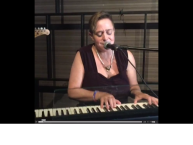\ By Donna Lypchuk for TorontoMoon.ca \
“The Handmaid’s Tale” has been on my mind a lot lately, not just because I have been a fan of Margaret Atwood’s brilliant dystopian novel since I first reviewed it in 1985, but mainly because I am sitting, where I sit every day, in one of the skeletal mid-century modern chairs at the Dark Horse Espresso Bar in the Canary District. In fact, I am sitting in the exact same chair that the main character of Offred in the series, played by Elizabeth Moss, was sitting just months ago. The Dark Horse was the location for several scenes in the Hulu series adaptation of Atwood’s novel. I am thinking, “I could be a character in ‘The Handmaid’s Tale’, an extra in the series, sitting here acting like nothing is wrong with our society.” And then I look around to see if anyone else might be thinking the same thing that I am, which is, “there is something wrong.”
I have been coming to this strangely Spartan spot every day since I moved to the Distillery District a couple of months ago because I enjoy the bleak vista of the empty parking lot, surrounded a weedy industrial fence encasing an abandoned parking lot that shimmers in the sun like a pitted mirror. Further in the distance is a massive park that consists solely of a brilliant green carpet (and not a single tree) that is shadowed by the sinuous towers of the Distillery District, which seem to appeal to the serfs below to somehow reach for the sky. Did I mention that the Dark Horse also plays great music? Dystopian tunes to write to as you measure out the distance between where you are in society and where those who live at the top of these pinnacles will always be.
I am drinking a Splenda-laced Americano, suffering from my usual Monday Morning Handmaid’s Tale hangover. After each airing Sunday night I am besot Monday morning by a virtually unshakeable sense of uneasiness caused by watching relentless elaborately art-directed images of female oppression set to some of my favorite feel-good tunes from the eighties and nineties, a cultural epoch in our century that was in essence my hey-day. At first, I didn’t enjoy the intrusion of the contemporary music into the episodes so much, simply because I thought it detracted from the nature of the dystopian fantasy and then I realized that this was done, in a genius way, to hook viewers into a sense that this is all happening in a not-so distant past.
Right now, at this moment, while I write this, the barista here is playing Chris Cornell’s “Suicide,” which completely suits the suppressive architecture of this place, which is both social and anti-social at the same time and offers a bleak, empty view through a jungle of weaving cement poles. This building was designed by the architecture firm Architects Alliance for the Pan Am games, which is well known for erecting many spindly totems to the Brutalism movement in Toronto —including very tall ones that would facilitate a fatal leap if one day the gendarmes ever came knocking at your door to take away all of your reproductive rights.
If you are going to be lonely and misunderstood and ruminate about political oppression, this is the place to be. It is no wonder that the creators of “The Handmaid’s Tale” chose to shoot several horrifying scenes in this stylish concrete café mausoleum devoted to the culture of caffeine. In a pivotal scene shot here the main character June, aka Offred, (played by Elizabeth Moss of “Mad Men”) and her best friend Moira (played by Samira Wiley of “Orange is the New Black”) are called sluts by a bitchy sterile barista, who is totally into the New Republic of Gilead, which is a patriarchal Christian theocracy that enslaves women. Shortly afterwards, the two BFFs are rounded up by gendarmes with machine guns (uncomfortably reminiscent of the G7 Summit corralling bystanders at Queen and Spadina a few years ago) and stripped of all their rights. Without spoiling too much of the plot for you, all you need to know is that the rounding up of all of the fertile woman and cloaking them in red capes is spurred by a need to keep the human race procreating because God has smitten most of the female population with a plague that makes them sterile.
The Hulu series, currently streaming whenever you want and also broadcasting every Sunday night at 9 on Bravo, feels strangely familiar to those of us who are watching what is happening politically in the United States right now. This ominous feeling, that we are all just frogs in a pot slowly waiting for the gendarmes to come and arrest us for thought crimes, is also greatly underscored by the presence of contemporary music on the soundtrack, many of which are my very favorites and are songs about personal rebellion. Some, such as the Lesley Gore anthem “You Don’t Own Me” that closes the first season credits, can be construed as deliberate feminist statements. After June (later christened Offred) and Moira attend a protest, after their jobs are taken away, a violent riot occurs that features the burning of files and books, set in, of all places, Toronto City Hall, filmed in slow motion and featuring Philip Glass’s version of “Heart of Glass”. The song “Don’t You Forget About Me” by the Smiths plays after Offred is cloaked and stripped of her identity, in a way that reminds us that anyone’s identity is all about their history. Other great songs that serve as ironic counterpoints to the narrative include “Daydream Believer”, by the Monkeys, “Can’t Get You Out of My Head” by Kylie Minogue, “Wild is The Wind” By Nina Simone, “He’s Alive” by Adam Taylor and “White Rabbit” by Jefferson Airplane.
This is not the first time that a screen adaptation has lived up quite adequately to this Atwood nova, as a movie starring Natasha Richardson, Faye Dunaway and Robert Duval was released in 1990. The script was adapted by iconic playwright Harold Pinter, it was directed by Voker Shlondorff and featured the incredibly haunting electronic stylings of the great Ryuichi Sakamato on the sound track. However, the movie lacked the immediacy of the present small-screen adaptation, which allows song lyrics to express what the characters are forbidden to speak.
The studied direction in the current adaptation allows for long silences and lots of staring, gesturing and strolling and little conversation, with the music piping in at just the right time to express a certain sentiment. Quite a few of the episodes were shot by the amazing Floria Sigusmondi, Toronto’s own artful dark visionary who has created music videos for David Bowie and Marilyn Mason. Her work in “The Handmaid’s Tale” is understated, tasteful and redolent of her signature sense of creeping, anticipatory menace.
I love the way music is used in The Handmaid’s Trail because it refers to one of its most noble and grand purposes, which is ultimately to express feelings when we can’t and to evoke feelings when the rigors of society have caused us to become depressed and numb. Listening to the now deceased Chris Cornell’s haunting voice echo through this large concrete room as I drain my Americano, most certainly evokes the loneliness of the person, who feels like a prisoner in a suppressive society and cannot find a way to escape. I feel that Atwood’s “The Handmaid’s Tale,” which initially terrified me with its visions of female slavery way back in 1985, is slowly becoming my present reality. Yes, I think, as a woman in a bright red dress strolls by, I am living the Handmaid’s Tale dream. Or rather, nightmare.






